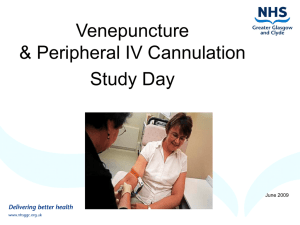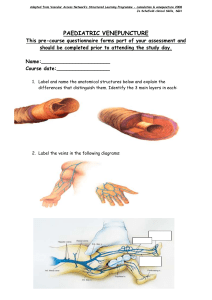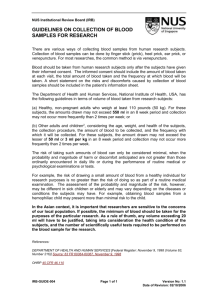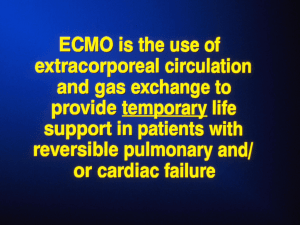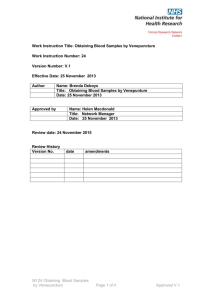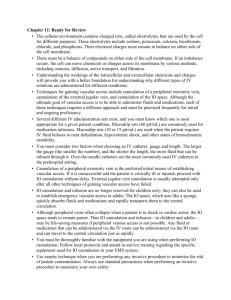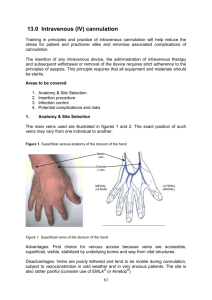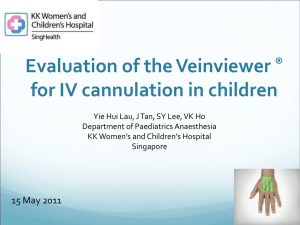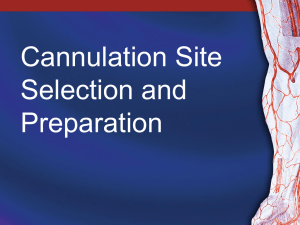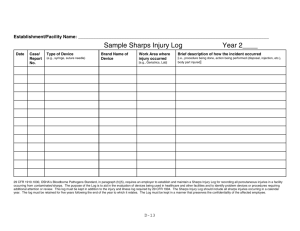Venepuncture and Cannulation Study Day
advertisement
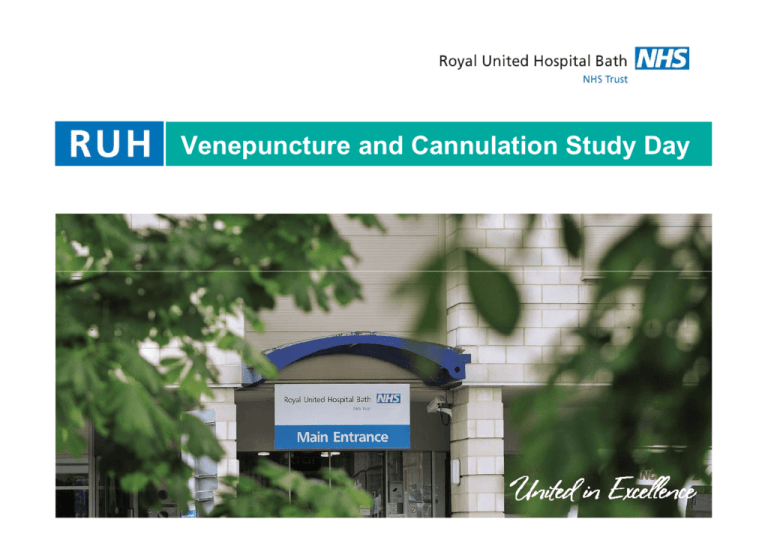
Venepuncture and Cannulation Study Day Objectives To understand Trust policies on venepuncture, cannulation & flushing To understand professional responsibilities relating to these skills To understand venous anatomy & physiology To understand infection control issues relating to the skills To understand potential complications & how to minimise the risks To understand the importance of documentation & aftercare To demonstrate safe & correct procedure on a training arm Timetable 08.45 09.00 09.15 09.30 10.00 10.20 10.35 12.00 12.35 14.30 15.00 15.15 15.45 Registration Guidelines for professional practice Venous anatomy and physiology Infection control issues Laboratory perspective Coffee Venepuncture equipment, technique & Practice Lunch Cannulation equipment, technique & practice Flushing peripheral venous cannula Coffee Complications, reflection & evaluation Close Professional Responsibilities All staff who practise venepuncture must have received approved training and documented, supervised practice. The onus is also on individuals to ensure their knowledge and skills are maintained, both from a theoretical and practical perspective. All practitioners must operate within the protocols/guidelines of their particular organisation Who can carry out the procedures? An Accountable practitioner! To include; Medical Staff Registered Nurse Midwives Radiographers Other non-registered staff who have undergone Trust approved training and have proved to be competent RUH Venepuncture Policy Guidelines for Professional Practice Duty of Care : Health and Safety Act Employment Law Civilly Liable to patients (you can be held liable for adverse effects to patients if procedures are not followed correctly ) Your safety, consider the risks Guidelines for Professional Practice IGNORANCE IS NOT A DEFENCE It is your responsibility to keep up to date with current practices Extended Roles Where do your responsibilities lie? Professional Responsibility Summary Never carry out a procedure that you have not been trained to do, signed as competent to do or do not feel confident to do. Registered and non-registered staff have responsibilities to act lawfully Keep up to date with current practices Remember these skills are extended roles and should not take priority over basic nursing care Venous Anatomy and Physiology Objectives Differentiate between an artery and a vein Identify and name the commonly used veins for venepuncture and cannulation Be aware of nerves in the arm Understand how to choose an appropriate vein for venepuncture and cannulation avoiding hazardous anatomical structures Anatomy and Physiology The most common site for venepuncture is the Antecubital Fossa where the Median Cubital, Cephalic and Basilic veins lie close to the skins surface making them easily accessible. They are the most prominent, there are numerous of them and they have been shown to minimise discomfort (Weinstein, 1997). Always use veins in the upper extremities before using lower extremity sites for VENEPUNCTURE. Veins of the lower limbs are usually only used in exceptional circumstances in adults. However! For CANNULATION you should start distally and work proximally Nerves of the Arm to consider.. Three main nerves run past the elbow and wrist to the hand. Median nerve. This nerve passes down the inside of the arm and crosses the front of the elbow.The median nerve supplies muscles that help bend the wrist and fingers. It is a main nerve for the muscles that bend the thumb. The median nerve also gives feeling to the skin on much of the hand around the palm, the thumb, and the index and middle fingers. When the median nerve is compressed over a long period, it can cause carpal tunnel syndrome. Nerves Ulnar nerve. This nerve passes down the inside of the arm. It then passes behind the elbow, where it lies in a groove between two bony points on the back and inner side of the elbow. The ulnar nerve supplies muscles that help bend the wrist and fingers, and that help move the fingers from side to side. It also gives feeling to the skin of the outer part of the hand, including the little finger and the outer half of the back of the hand, palm, and ring finger. When the elbow is bumped over the ulnar nerve, it's often called hitting the "funny bone." Nerves continued Radial nerve. This nerve passes down the back and outside of the upper arm. The radial nerve supplies muscles that straighten the elbow, and lift and straighten the wrist, thumb, and fingers. The radial nerve gives feeling to the skin on the outside of the thumb and on the back of the hand and the index finger, middle finger, and half of the ring finger. Main nerves of the Arm Differences between arteries and veins ARTERIES Take oxygenated blood from the heart to tissues Have thick walls Small Lumen Elastic No valves Deep seated (Usually) Do not collapse High pressure VEINS Take deoxygenated blood from the tissues to the heart Thin walls Large lumen Less elastic Have valves to prevent any backflow of blood Lie closer to the skin Tendency to collapse Low blood pressure Vein Structure Anatomy The structure of a vein is as follows; The walls (outer structure) of veins consist of three layers of tissues that are thinner and less elastic than the corresponding layers of arteries. Veins include valves that aid the return of blood to the heart by preventing blood from flowing in the reverse direction. Vein and Artery Structure Tunica Intima (inner lining) ; has a smooth lining, is fragile and sensitive. Valves are present here in veins. Tunica Media (Middle lining) ; Smooth muscle, elastic tissue which can constrict and dilate. Less thick in veins Tunica Externa or Adventitia; thick layer of connective tissue Suitable Veins Visible Palpable Bouncy Soft Well supported Refills when depressed Straight and non-toruous Sites to avoid… Evidence of venous fibrosis; Evidence of haematoma/oedema formation; Evidence of localised infection/inflammation; Any vascular access device; Fistulae or vascular grafts. Limbs with fractures Small, visible but impalpable veins The affected side in patients postmastectomy or postcardiovascular accident. Anatomy and Physiology Summary Only perform venepuncture and cannulation on healthy tissue Be aware of the artery at the Antecubital Fossa Be aware of the nerves at the Antecubital Fossa In some individuals the artery lies over the vein so remember to check if there is a pulse! If your ever not sure, then always ask. Infection Control Issues Why do you think Infection Control is a relevant issues with regards to venepuncture and cannulation ?? Sharps Safety (RUH Sharps Policy) Take sharps bin to patient Sharps must be disposed of immediately Fill to line only Never re-sheath needles Report sharps injuries as per RUH policy Key Principles for sharps 1. 2. 3. 4. 5. 6. Never attempt to use a sharp without preparation for its disposal Never re-sheath a needle (Even a clean one) Never carry loose sharps in your hand- always use a plastic tray Never expect someone else to dispose of your sharps Never leave sharps to dispose of later Never underestimate the implications of a sharps injury Key Principles Sharps ALWAYS 1. Wear appropriate personal protective equipment 2. Assemble devices with care 3. Be especially vigilant during emergency situations and procedures 4. Ask for assistance when taking blood from uncooperative patients 5. Dispose of sharps as soon as possible 6. Report all incidents involing contaminated sharps 7. Report all near misses and examples of bad practice 8. Prohibit hand to hand passing of sharps devices. Infection control key points and summary Always use ANTT when performing venepuncture and cannulation as will reduce the risk of patients developing bacteraemias Tourniquets should be single use Remember the correct disposal of equipment as per RUH policy Sharps injuries do happen!! Think personal protective equipment and your safety Venepuncture Equipment, Technique and Practice 4 stage techniques 1. Visual picture of skill demonstrated in real time 2. Explanation of demonstration 3. Student talk through whilst performed by trainer 4. Student talks through and demonstrates the skill BUT FIRST A FEW KEY POINTS Patient Consent How do we gain consent from our patients? How do we correctly identify our patients? What about confused or unconscious patients? Venepuncture Checklist Have you checked and confirmed the identity of the patient? Have you obtained verbal informed consent? Has the use of local anaesthesia been considered? Have you selected all equipment required? Does the patient have any IV infusion in progress in the limb you propose to use? ANTT If the tourniquet is non-disposable, is it socially clean and has it been laundered at 60˚c within the last 7 days? Have you disposed of any waste including sharps, in accordance with trust policies? Have you documented the procedure? Venepuncture key points How many attempts will you have at any one given time for a single patient? What will you do if you have been unsuccessful? Where do you document the procedure? Order of Collection Blood Cultures, then Blue Top (Clotting screen) Orange/ beige top (Chemistry profile) Lavender top ( Full Blood Count (FBC)) Labelling of blood bottles 1. 2. 3. 4. How to label… Use a ball point pen Include full name, D.O.B, Ward, date and time Write the time of collection on the request form and initial the form Place the tubes in the bag and attach the blood form and seal THINK IS THIS BLOOD NEEDED URGENTLY? WHAT ARRANGMENTS WILL YOU NEED TO MAKE? Any Questions? Venepuncture summary and key points Always gain consent Always wear gloves when carrying out venepuncture and cannulation Always use vacutainer equipment when taking blood, never a needle and syringe Always label blood bottles immediately after taken Always follow trust policy and guidelines Always perform the skill under direct supervision by a trained member of staff competent in the skill and who uses them regularly, until such time that you are signed off as competent Venepuncture. LETS PRACTICE! Peripheral Cannulation Aim and Objectives AIM To provide a guide to peripheral intravenous cannulation and advice on the continuing care of patients with such devices in place. Objectives Each practitioner will be able to: Ensure that a short peripheral cannula is the appropriate device for intended need Decide the size/type of device to be used Choose an appropriate insertion site Prepare the appropriate equipment Complete the procedure safely Conclude the care episode Cannulation Why is cannulation necessary for some patients? What size cannula? Before beginning it is important to choose the correct size of cannula. The options, in order of decreasing bore size are; 16 gauge (grey) for surgical emergencies (170mls/min); 18 gauge (green) for blood transfusions or larger volumes (80mls/min); 20 gauge (pink) for maintenance of intravenous fluids; and 22 gauge (blue) for difficult veins, slow intravenous fluids, or intravenous drugs in a patient who can take oral fluids (31mls/min) Cannula selection The cannula chosen should be the smallest to meet the clinical need. Clearly the larger the lumen of the catheter the faster the flow rate. The indication for cannulation should be considered and the cannula gauge chosen accordingly. For example emergency colloid or blood replacement after a post partum haemorrhage will require a grey cannula whereas a line for intermittent intravenous bolus injections of antibiotics could be green or pink. Think; purpose of infusion, type of infusate, length of treatment Insertion site Commonly chosen sites include: Veins in the back of the hand or forearm. In an emergency any available large peripheral vein may be used e.g. median cubital vein in the anti-cubital fossa. If the cannula has to be positioned over a joint a splint may be required to ensure continuing satisfactory flow. Cannulation documentation What needs to be considered with regards to the documentation of cannula? What aftercare considerations are there? Any Questions? Cannulation. LETS PRACTICE!! Potential Complication Objectives To understand the potential complications of Venepuncture and Cannulation To understand how to deal with such complications if they should occur Potential complications Syncope / fainting Haematoma / bruising Petechiae / broken capillary blood vessels Haemolysis Infection Infiltration Extravasation Occlusion Embolus Complications continued Haematoma If a haematoma begins to form, release the tourniquet, remove the needle from the vein and apply firm pressure to the site. The incidence of haematoma after venepuncture can be decreased by applying pressure to the site after the needle is removed. Carefull technique should reduce the risk of developing a haematoma. Complications continued Petechiae A petechiae is a small (1-2mm) red or purple spot on the body, caused by a minor haemorrhage (broken capillary blood vessel) This often occurs in patients with a coagulopathy but can also occur if the tourniquet is left tightened for prolonged periods of time Complications continued Haemolysis Haemolysis can affect some results (e.g. potassium), although it may be a result of the patients disease process it is most often the result of poor technique. Remember to invert the blood tubes gently to mix the blood. Complications continued Infection Local cellulitis or septicaemia are uncommon complications of venepuncture- remember strict asceptic technique during venepuncture and cannulation will reduce the risk of patients developing a bacteraemia. REMEMBER ANTT!! All patient with an intravenous access device in place must have the cannula site checked daily for signs of infusion phlebitis. Two of the most common causes of infusion phlebitis are chemical and mechanical; therefore the correct choice of a suitable access device for a particular patient is vital (Freytes 2000). Cannulation and Infusion Complications INFILTRATION – Inadvertent administration of a non-vesicant solution or drug into the tissues (Weinstein 1997). Venous access devices must be secured in away that does not impede fluid/blood flow and allows the insertion site to be monitored. EXTRAVASATION – Inadvertent administration of a vesicant solution or drug into the tissues (Weinstein 1997)). Tissue necrosis may follow, therefore it is vital that cannulae are assessed as patent prior to use and monitored closely. Infiltration and extravasation How will you tell if this occurs? 1. Pain when flushing 2. Possible swelling distally to the cannula 3. Pressure when attempting to flush Prevention 1. Close observation 2. Regular flushing 3. Careful fixation REMEMBER VIP SCORE EVERY SHIFT!! Complications continued OCCLUSION – Cannulae may become occluded when infusion containers ‘run dry’ or flush solutions are not administered appropriately (Dougherty and Lamb 1999). Cannula’s must never be forcibly flushed. Remember VIP SCORES!! Complications continued Embolus, air or blood Ensure all connections are tight. Never reintroduce stylet If clotted then remove Careful when drawing up the flush to prevent air bubbles. Questions 1. 2. 3. 4. What action should you take in the event of an injury to a nerve? Remove the needle immediately and apply pressure Seek medical help Give an explanation to the patient Make sure the incident is documented and fill out an incident form Questions 1. 2. 3. 4. What action should you take in the event of puncturing an artery? Remove device immediately and apply pressure until bleeding stops and then apply an appropriate dressing Seek medical help Document in the notes Give an explanation to the patient Complications summary Remember never to rush Careful technique will reduce incidents of complications Document all attempts as per trust policy Only two attempts for the same patient episode. Always ask someone if you are not sure. Any Questions? Key points You need to be signed of by a competent practitioner before you are able to practice the skills alone, that includes competencies for; Venepuncture Cannulation Flushing There is also a competency for sending blood for cross match or group and save. Speak to a competent staff member in your ward areas. Objectives To understand Trust policies on venepuncture, cannulation & flushing To understand professional responsibilities relating to these skills To understand venous anatomy & physiology To understand infection control issues relating to the skills To understand potential complications & how to minimise the risks To understand the importance of documentation & aftercare To demonstrate safe & correct procedure on a training arm References and further reading Campbell, H et al (1999) A practical guide to venepuncture and management of complications, British Journal of Nursing 8 (7) 426-431 Heywood Jones, I (1994) Venepuncture –using vacuum tubes, Community Outlook 7, 21-22 Griffths, E. (1999) Venepuncture. Practice Nursing 10 (1) 23-25 Scales, K (2008) A practical guide to venepuncture and blood sampling. Nursing standard, 22 (29) 29-36 Witt, B (2004) The Royal Marsden Hospital Manual of Clinical Nursing Procedures. 6th ed. Oxford, Blackwell pp774-785 RUH Venepuncture Policy (2009) accessed via intranet Lavery, I (2003) Peripheral venous cannulation and patient consent. 17 (28) 4042 References continued NHS National Patient Safety Agency (2007) “right patient, right blood” BDS 19 Preparing to administer blood/ blood components to patient and administering a transfusion of blood DoH (2006) Saving Lives: High Impact Interventions No. 1 Preventing the risk of microbial contamination The Royal Marsden (2006) Clinical Nursing Procedures 6th Ed, Blackwell Publishing LTD Clinical Governance 17, Collection of Blood Samples Campbell, L (1998) IVrelated phlebitis, complications and length of hospital stay References continued Jackson, A (1997) Performing peripheral intravenous cannulation. Professional Nurse. 13 (1) 21-25 Jackson, A (2003) reflecting on the nursing contribution to vascular access. British journal of nursing 12(11) 657- 665 Scales, K. (2005) vascular access. A guide to peripheral venous cannulation. Nursing standard 19 (49) 48-52
